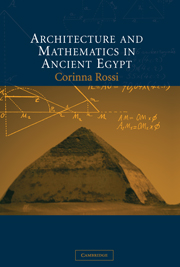Book contents
- Frontmatter
- Contents
- List of illustrations
- List of tables
- Preface
- Acknowledgments
- List of abbreviations
- Part I Proportions in ancient Egyptian architecture
- Part I Ancient Egyptian sources: construction and representation of space
- Introduction to Part II: Tradition and variations in ancient Egyptian art and architecture
- 3 Documents on the planning and building process
- 4 Foundation rituals
- Conclusion to Part II: From the plan to the building
- Part III The geometry of pyramids
- Conclusion to Part III: Interpreting the slope of pyramids
- An overview
- Appendix: List of Old and Middle Kingdom true pyramids
- Bibliography
- Index
Conclusion to Part II: From the plan to the building
Published online by Cambridge University Press: 27 February 2010
- Frontmatter
- Contents
- List of illustrations
- List of tables
- Preface
- Acknowledgments
- List of abbreviations
- Part I Proportions in ancient Egyptian architecture
- Part I Ancient Egyptian sources: construction and representation of space
- Introduction to Part II: Tradition and variations in ancient Egyptian art and architecture
- 3 Documents on the planning and building process
- 4 Foundation rituals
- Conclusion to Part II: From the plan to the building
- Part III The geometry of pyramids
- Conclusion to Part III: Interpreting the slope of pyramids
- An overview
- Appendix: List of Old and Middle Kingdom true pyramids
- Bibliography
- Index
Summary
The picture that appears at the end of this study of ancient Egyptian documents on the planning and building process shows that the ancient architects used a combination of drawings, models and written specifications to describe and create their buildings. None of these methods, alone, pretended to be exhaustive in the description of the actual building, but each could provide partial information on the final result.
Where entire buildings were concerned, drawings had the function of describing the general arrangement and the overall proportions, whilst the precise dimensions were indicated by written specifications. The limited available surface on which architects could draw, moreover, prevented the drawings from being able to describe large buildings with a great degree of detail. Ostraca larger and heavier than a certain limit would have been uncomfortable to handle and, apart from a few exceptions, the average papyri were less than 50 cm high.
The absence of scale drawings sweeps away any attempt to prove that complicated mathematical patterns were used in the project. That they were absent in the practice of construction, too, is suggested by the fact that the most successful and convincing analyses of the dimensions of ancient Egyptian monuments are those based on simple measurements. Some excellent examples of this are Dieter Arnold's studies on the temple of Mentuhotep at Deir el-Bahari and of the pyramid complex of Amenemhat III at Dahshur. Seemingly, the surviving projects of royal tombs suggest that the ancient architects started, if possible, from round measures.
- Type
- Chapter
- Information
- Architecture and Mathematics in Ancient Egypt , pp. 174 - 176Publisher: Cambridge University PressPrint publication year: 2004



